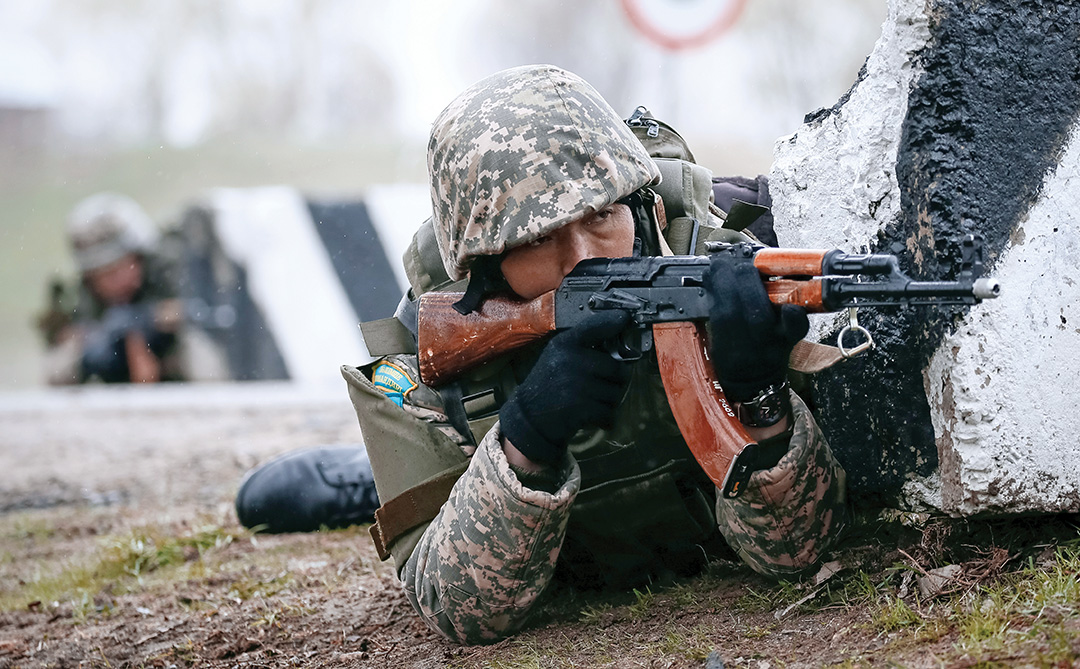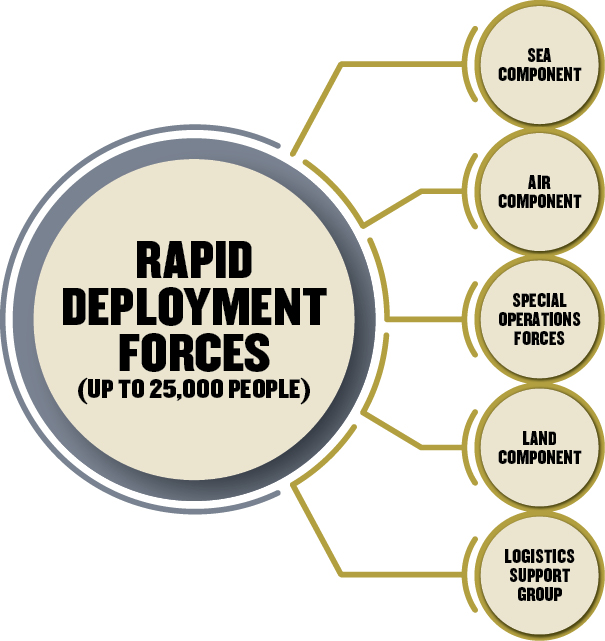New Kinds of Conflict
Hybrid warfare threatens to test the capacities of modern militaries
Maj. Gen. ASKHAT N. RYSPAYEV
HEAD OF the NATIONAL DEFENSE UNIVERSITY, KAZAKHSTAN
Photos by Reuters
The international situation is extremely complex, tense and periodically intensifies the contradictions between countries and ethnic, religious, political, social and other groups, which cause various conflicts.
Despite the world’s declared desire to resolve conflicts by peaceful means, military force remains one of the main tools for resolving these problems. We see the need for an in-depth study of the causes and nature of military conflicts.
First, let us consider the concept of such conflicts. According to the definitions accepted worldwide and in Kazakhstan, military confrontation is a unifying and integrating concept, a form of resolving conflicts between conflicting parties with the use of military force to achieve certain political goals.
However, several trends have recently transformed the nature of military conflicts. Aggressors pursue their political and economic interests by compelling their opponents to accept their aims using traditional and nontraditional methods short of outright warfare.
The development of the means of armed struggle has a great influence on its content and on the nature of the conflicts. Armed struggle using the latest traditional and nontraditional means acquires new features.
In the media, we hear new terms such as “hybrid wars,” “cloud opponent,” “controlled chaos” and “cyber weapons.” The most widespread term used recently is “hybrid wars” or “hybrid threats.”
The strategies of hybrid wars and recommendations on confronting these hybrid threats have been developed in the United States and NATO. This analysis suggests fundamental changes in the nature of war. The essence of these changes is to prepare for and influence the outcome of hybrid war using military and irregular components with the involvement of the civilian sector.

Hybrid war implies a wide range of hostile actions, in which the military plays a relatively small role. The main means of inflicting damage to the enemy are political, informational/psychological and economic. Its methods make it possible to achieve tangible results — they inflict territorial, political and economic damage to the enemy, disorganize an opponent’s system of government and demoralize society.
Such war is not perceived as a war in the classical sense. Foreign Minister of Denmark Martin Lidegaard gave a fairly clear description of the hybrid war in 2014: “I wouldn’t call it military, necessarily; it’s a hybrid war where you have massive propaganda, provocations, stimulation of groups inside other countries, which is not warfare but which is something very hostile and close to warfare.”
In traditional warfare, the main means for achieving goals are the use of regular armed forces, and other types of influences on the enemy are subordinated. To improve the ability of Western countries to confront new hybrid threats, close coordination is being established with ministries of the interior, involving police and gendarmerie forces to curb unconventional threats associated with propaganda campaigns, cyber attacks and actions by local separatists.
Conducting exercises to practice reactions to hybrid war is called one of the priorities of the NATO alliance. In Latvia, NATO has established a Strategic Communications Centre of Excellence to prepare and coordinate such exercises.
The concept of hybrid threats unites a wide range of hostile circumstances and intentions, such as cyber war, asymmetric low-intensity conflicts, global terrorism, piracy, illegal migration, corruption, ethnic and religious conflicts, security of resources, demographic challenges, transnational organized crime, globalization problems and the proliferation of weapons of mass destruction.
 An important step in the preparation for a new type of war is the decision by NATO to establish a combined-arms rapid deployment force that can be ready within 48 hours to conduct initial operations. It will include ground, air and naval forces, as well as special operations forces.
An important step in the preparation for a new type of war is the decision by NATO to establish a combined-arms rapid deployment force that can be ready within 48 hours to conduct initial operations. It will include ground, air and naval forces, as well as special operations forces.
The complex composition of the NATO force suggests that this formation can be used to solve two fundamentally different tasks. One will be to prevent enemy sabotage and reconnaissance during the threatened period, to fight irregular formations on its own territory. The other is to organize subversive work on enemy territory by creating irregular network structures involving human and material resources.
A complex of hybrid threats is formed according to a predetermined strategic plan and affects a wide range of enemy military and civilian targets, including the population of the target country. The ultimate goal is to undermine the total power of the state and the positions and influence of the government within the country and in the international arena.
Thus, unlike other types of threats, the complex of hybrid threats is guided strictly by the chosen target object (the specific target country), has a clearly defined format and a predetermined goal, and is strategically central to the operation.
The successful implementation of a set of threats depends on the availability of a source capable of providing the necessary forces and facilities, as well as the access to them. Such a synergistic effect of the use of hybrid threats causes a special danger to the national security of a country.
About the author: Maj. Gen. Askhat Ryspayev, Ph.D., has been head of Kazakhstan’s National Defense University since 2012. Much of his military career has entailed helping rebuild his nation’s military after it achieved independence from the former Soviet Union.


Comments are closed.